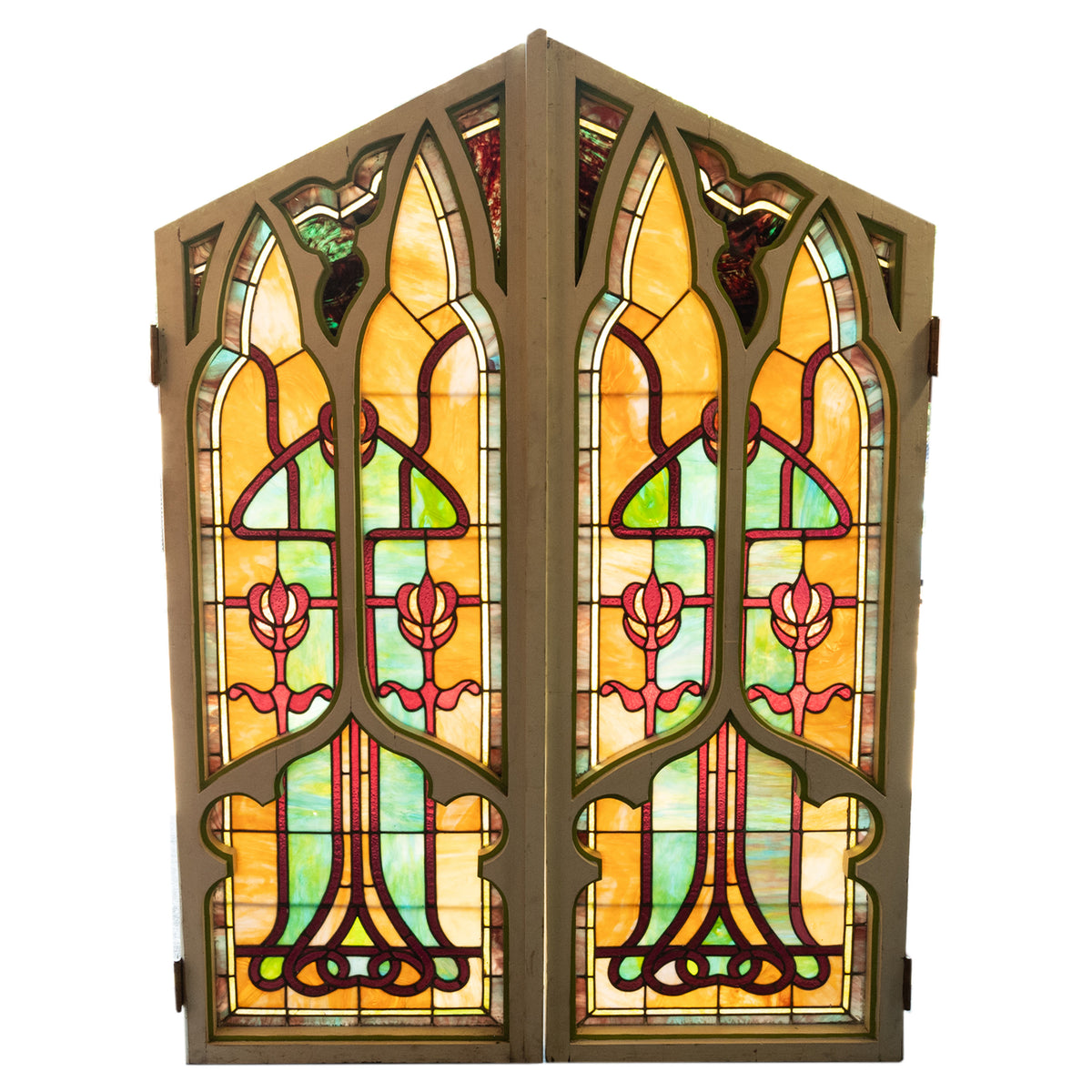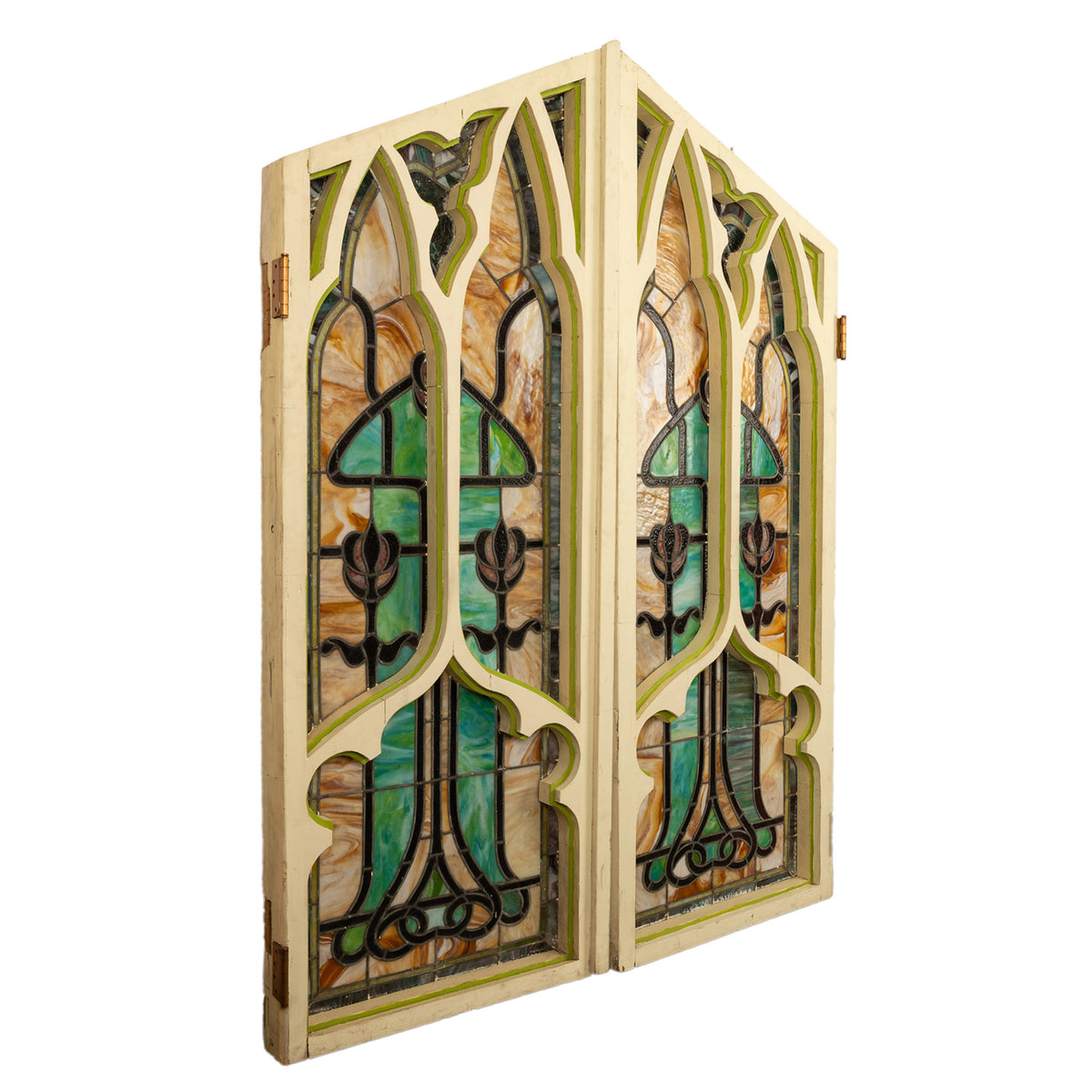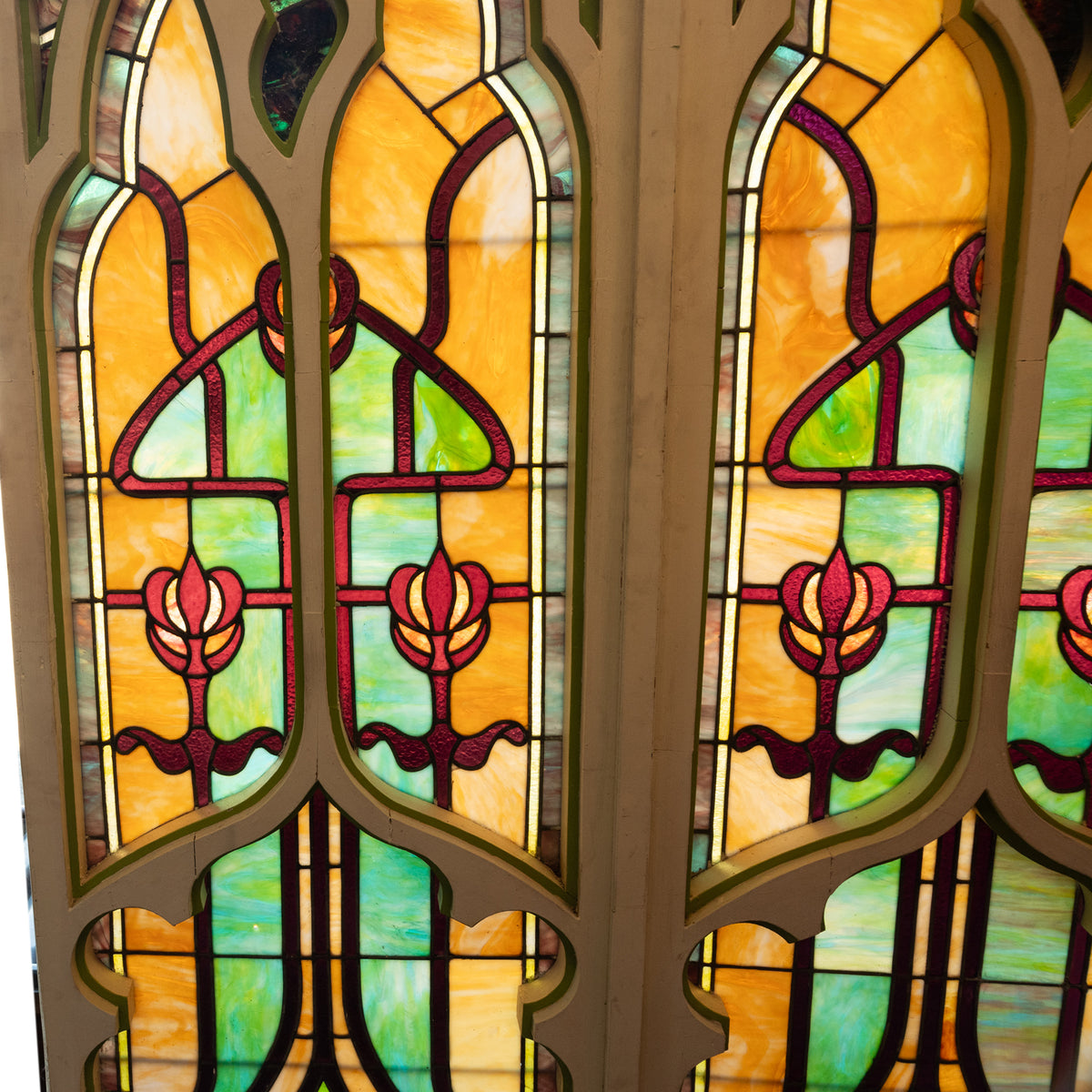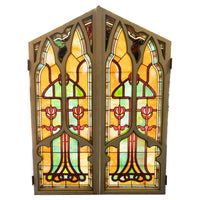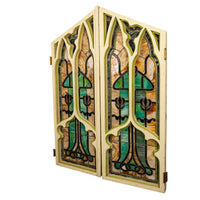Pair Antique American Stained Glass Gothic Art Nouveau Doors Windows Povey Bros Circa 1900
- Regular
- $ 11,995
- Sale
- $ 11,995
- Regular
- Unit Price
- per
A rare & important pair of antique American Art Nouveau with Gothic frames stained glass doors/windows, by Povey Brothers, Portland Oregon, circa 1900. Over 6.5' in height.
Povey Brothers were the preeminent stained glass makers located in Portland Oregon, they produced stained glass to rival that of Louis Comfort Tiffany, please see their biography below. This important pair of stained and leaded glass doors/windows are quintessentially in the Art Nouveau style with sinuous organic floral designs, the windows are housed in the original gothic arch frames. The glass is a mixture of Kokomo, rippled and textured glass, all the leading is tight and remarkably there are no cracked panes or damage. These doors were most likely for a residential project with the absence of any ecclesiastical design, By family repute were confirmed as being produced by Povey Bros by the architect & daughter of David Lincoln Povey, Polly Povey Thompson. The images show the doors with both natural light filtering through and also without natural light coming through,
condition is excellent, a fine & rare pair of antique Art Nouveau stained glass doors/windows by The Povey Brothers, circa 1900.
Povey Brothers Studio, also known as Povey Brothers Art Glass Works or Povey Bros. Glass Co., was an American producer of stained glass windows based in Portland, Oregon. The studio was active from 1888 to 1928. As the largest and best known art glass company in Oregon, it produced windows for homes, churches, and commercial buildings throughout the West. When the firm was founded in 1888, it was the only creative window firm in Portland,
Povey Brothers was known as the "Tiffany of the Northwest" and many of the company's windows still exist in historic buildings throughout the region, including those on the National Register of Historic Places.
The windows were considered to have extraordinary quality and beauty, and the firm's work was virtually unequaled in the Pacific Northwest. The heyday of Povey Brothers coincided with the growing economic affluence of the region, and the brothers' work was much sought after by the new rich to decorate the large houses they were building. Of this sort of installation, art glass expert Michael Mc Cary said, "People who put in that kind of glass were kind of showing off." The Great Depression and changes in house styles eventually caused demand for the brothers' work to decline, however. Today Povey Brothers windows are a mark of pride in many landmark buildings in Portland
The company was founded by David Lincoln Povey, the son of English-born stained glass window maker Joseph Povey, who immigrated to the United States in 1848 and subsequently worked in stained glass in Philadelphia, New York City, and Newark, New Jersey. The family, who had been in the stained glass trade for generations, eventually settled in St. Louis, Missouri. David Povey was born in 1865. He studied art at Cooper Union in New York and traveled in Europe for further study before moving to Portland. David formed the glass company in 1888 with his brother John, shortly after working on a commission for First Presbyterian Church. The company incorporated in 1893. John was the main craftsman and did the glazing and leading, while David did the design and art work. Their brother George Povey later joined the company as its accountant and business manager, and two Povey sisters also worked for the company. All three of the brothers worked in various glass studios on the East Coast before establishing their Portland shop. At the height of their business, the brothers employed 25 workers, including several Povey family members. David died in 1924 and his sons David and Darrel took over the business. In 1925, they hired Albert Gerlach, formerly of Giannini & Hilgart in Chicago and trained at the Art Institute of Chicago, to assist in the business. The Povey Brothers sold the company to W. P. Fuller in 1930, and Gerlach remained at the company until 1950.
John Povey died in 1917. His Queen Anne Victorian home in the Irvington neighborhood, the John E. G. Povey House, is listed on the National Register of Historic Places.
David Povey's daughter, Portland architect Polly Povey Thompson, had planned to write a book on her father's works, but she died in 1994 before it could be completed. Povey windows continue to be documented. George Povey's granddaughter, Laurie Povey Crawford, of Everett, Washington, did not know that the First Presbyterian Church in Everett held Povey windows until 2015
The brothers imported their glass from Europe, but designed and constructed their windows in Portland. They often used opalescent glass in their work, a style that John La Farge and Louis Tiffany had pioneered in the 1870s. Their church windows were done in a Classical style often based on famous religious paintings, such as those by Raphael, and had images or scenes painted on non-opalescent glass. They were also noted for their use of "jewels", small, thickly cut faceted pieces of glass in rich colors, and for several other types and textures of glass, including Kokomo, crackle, rippled, granite-textured, and machine-rolled. The studio's early residential work was colorful and ornate, often using Art Nouveau motifs, and later work was influenced by the Arts and Crafts Movement. Popular motifs included grape clusters, roses, lilies, birds, and dogwood, which became a signature of the company. Another notable feature of the studio's work was the use of clear glass in the background to allow light to pass through the windows on the Northwest's typically overcast days.
Besides windows, the company also designed other glass products, including light fixtures that had a horizontal Prairie School design influence.
The studio was known for using the latest equipment and trade techniques, and for working with architects and homeowners to create unique designs that set the Poveys apart. David Povey, who developed a distinct style, designed virtually every window that left the studio. While the company's residential work was often small in scale, its church installations could be quite massive, with multiple panels.
Most Povey windows are not signed, which led to imitators passing off their work as the Poveys'. It also makes the Poveys' work difficult to identify. In 1923, David Povey began signing the widows with "Povey Brothers Studio" and the year of completion. This may have first been done for the windows of the First Christian Church in Portland, and the last such signatures may have been on the windows of Atkinson Memorial Church in 1924, the year David died.
By 1889, the Povey Brothers Studio was located in the Phoenix Building at 124 SW Ash Street in Portland. The building is a contributing property in the Skidmore/Old Town Historic District.
In 1905, the company relocated to the Povey Building at 408 NW 5th Avenue in Portland, designed for them by architect Emil Schacht. The company was still located there in 1926. The Povey Building is a contributing property to the Portland New Chinatown/Japantown Historic District.
Imperial
ches high × ches wide × ches deep
Metric
high × wide x deep
Displayed rates are for shipping in the Continental U.S. and Canada. For other locations, kindly contact us and we will provide the most competitive shipping price available. All shipments are professionally packed and shipped insured with full tracking capabilities. Customers are also welcome to collect their items from our warehouses or arrange their own shipping.

